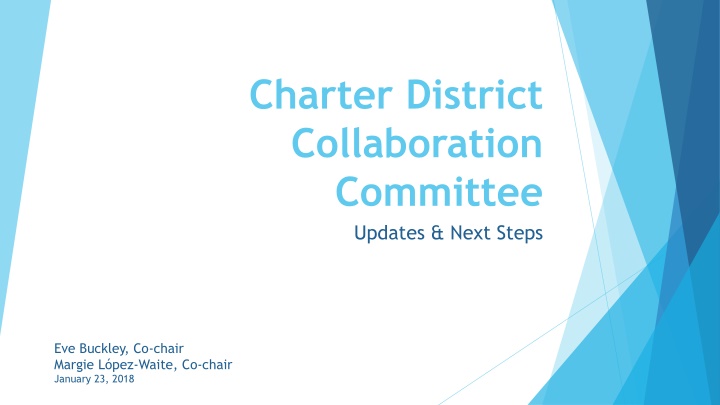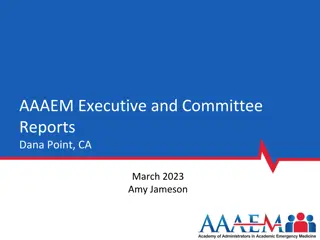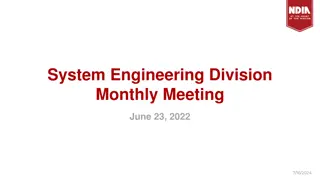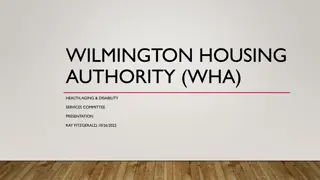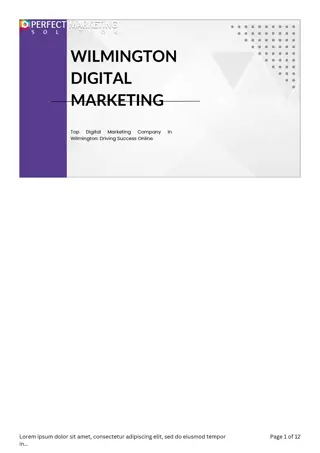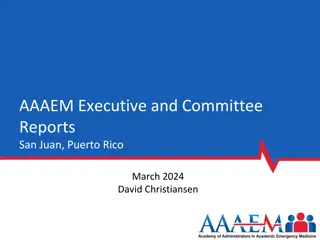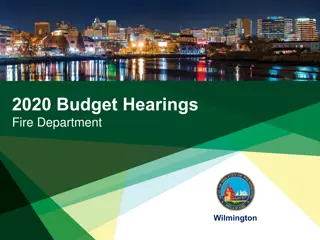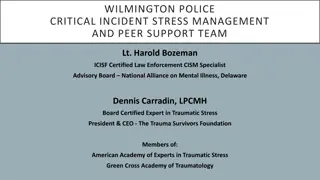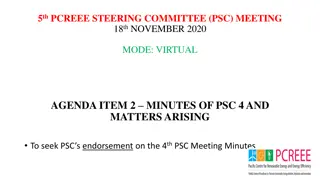Wilmington Compact Committee Updates & Collaboration Efforts Summary
Wilmington Compact Committee, dedicated to promoting collaboration among schools in Delaware, reviewed areas of focus such as transportation, professional development, and trauma-informed practices. Identified collaboration areas included language immersion programs and strengthening hiring pools. Future plans involve organizing meetings with community stakeholders and planning a fall collaboration event.
Download Presentation

Please find below an Image/Link to download the presentation.
The content on the website is provided AS IS for your information and personal use only. It may not be sold, licensed, or shared on other websites without obtaining consent from the author.If you encounter any issues during the download, it is possible that the publisher has removed the file from their server.
You are allowed to download the files provided on this website for personal or commercial use, subject to the condition that they are used lawfully. All files are the property of their respective owners.
The content on the website is provided AS IS for your information and personal use only. It may not be sold, licensed, or shared on other websites without obtaining consent from the author.
E N D
Presentation Transcript
Charter District Collaboration Committee Updates & Next Steps Eve Buckley, Co-chair Margie L pez-Waite, Co-chair January 23, 2018
Committee Charge Promote shared capacity and collaboration among district, charter, and vo-tech schools within the state Recommend the application of national best practices for the overall improvement of public education in Delaware To support the development of a statewide plan for the configuration of schools
Wilmington Compact Overview A compact is a non-legislative, voluntary, formal public agreement. Guiding Principles for the Compact: Make decisions in the best interest of all students Build trust, mutual respect, and an inclusive environment for schools to participate Share a commitment to clear, honest, and open communication Limit competition among the various stakeholder groups Goals: Shared resources, shared goals, and shared responsibility for student success Celebration and promotion of success across all schools Improved public education system
Wilmington Compact: Work Underway To gain momentum for the Compact and identify key areas of collaboration, Commission and Committee leaders met with five school leaders of Wilmington Schools.
Main Areas of Collaboration Identified Three main areas of collaboration were identified: Transportation Professional development Trauma-informed practices Other collaboration areas discussed: Shared best practices Language immersion programs Food and Nutrition services Substitutes Strengthening hiring pool in Delaware
Upcoming Meetings & Next Steps Another round of meetings will target charter schools and community stakeholders. Next Steps Set date and venue for a fall collaboration event Divide responsibilities among committee members Begin planning, with input from other individuals & organizations
Our Own Example of a Collaborative Effort Las Am ricas ASPIRA Academy Colonial School District Goal: To establish a high school program to support a biliteracy pathway through 12th grade without interfering with the growth and stability of LAAA. Goal: To establish a biliteracy pathway within their International Studies Program to support the growth of their immersion program. ASPIRA International Studies Program at WPHS Goal: To establish a compact to achieve our mutual goals to provide students with a biliteracy pathway through high school and into college and/or career.
Parent, Educator, and Community Engagement Committee Updates & Next Steps Tizzy Lockman, Co-chair Whitney Williams, Co-chair January 23, 2018
Committee Charge Strengthening parent and family engagement in public education Supporting schools as community assets with allies from all sectors Promoting ongoing, effective, two-way communication with parents, educators, and the community.
Work Underway: 2017-2018 Parent Information Project The Parent Information Project helps parents and guardians navigate the school choice process and choose the school that is the best fit for their child and family. Parent Survey Project This project identifies and measures political efficacy of parents in schools and why parents do or do not engage in certain school programs.
Parent Information Project: Overview The project helps parents understand: Steps to navigating school choice The choice application timeline Key things to consider when looking at schools Parent rights and responsibilities Committee Outreach techniques: Holding information sessions in various locations in Wilmington 3 locations (CCAC, Hicks, LACC), more to come Interacting with parents, guardians, and families in the community, offering supports Engaging key community stakeholders
Parent Information Project: Results Approximately 500 physical info sheets distributed (more virtually) Approximately 50 workshop participants 16 coaching signups 4 families (6 children) ultimately assisted completing applications; follow up through invitation/acceptance (Feb/March)
Parent Information Project: Next Steps Program continues to assist with applications for open seats (charters, et al) and preparing families for 2019-20 school year applications. Ally analyzing data on outreach, process and partnerships Training volunteers to increase capacity
Parent Survey Project: Results Approximately 100 surveys filled out (online and paper surveys) Call to Action! Commissioners can help by distributing the survey link broadly and repeatedly (social media, community events, endorsing it, etc.). Commissioners can come out and collect data Must be or get CITI trained. Giving away $1500 in gift cards! Survey links: tinyurl.com/wilmschoolsurvey and tinyurl.com/wilmschools
Parent Survey Project: Next Steps Send initial results to Qualtrics Analyze results, initial numbers expected at the end of March 2018 At the end of school year 2018, data collection will wrap up and the process will repeat with as many surveys as we have
Committee Update Joint Work with Meeting the Needs of Students in Poverty Committee As PIP & survey continue and demonstrate need, PEaCE is joining forces with MNSP to pursue further pilot projects to move needle for student achievement through family engagement
Commission Policy Priorities January 23, 2018
Proposed Policy Issue Priorities for 2018 Transient students in the City of Wilmington. Reduce disruptions to students educations by allowing students who relocate to a new residence in the city to remain in their home school until completing the current school year. Investments in early childhood education. Expand investment, both fiscal and other forms, to meet the needs of all students but especially high needs students. Encourage the Family Services Cabinet Council to call on the Early Childhood Council to develop an update of the state s 2013 Early Childhood Strategic Plan. State and local services for low-income children and their families. Call on the Family Services Cabinet Council to develop a plan for low-income residents and for schools with high concentrations of low-income students, including the integration of services and partnerships with private and nonprofit institutions. Collaborative compact among districts and charters serving Wilmington students. Establish a compact among district and charter schools located within the City of Wilmington to better support operational improvements and share best practices of all schools. DRAFT
Proposed Policy Issue Priorities for 2018 Funding for low-income students. Continue to campaign for recurring State funding to all Delaware public schools for low- income students, English language learners, and basic special education students K 3. The neediest students require more than opportunity grants. Ensure the new ESSA requirement is implemented with a standard reporting system across all LEAs. Revenue base supporting public education. Strengthen and stabilize the revenue base at both the state and local levels, including property reassessment undertaken on a statewide basis and at regular intervals. P-20 Council. Strengthen, and prospectively reconstitute, the State P-20 Council and reaffirm its mandate to mobilize support for all educational transitions from birth through entry into the workforce or college. DRAFT
Asset Mapping Brief Institute for Public Administration on behalf of the Commission and MNSP Committee Kelly Sherretz Haley Qaissaunee Melissa Micek January 23, 2018
Purpose The City of Wilmington has the highest rate of children living in poverty in the state of Delaware. This study is an attempt to respond to the Commission s recommendations, focusing on: What public and nonprofit community resource institutions are located in Wilmington? What types of services these organizations provide, who they serve, where they are located How their location and operation corresponds to the needs of the City s children and families, particularly their availability in neighborhoods with high concentrations of poverty. Sources: KIDS COUNT in Delaware, 2017
DRAFT Heat Map of All Programs, Wilmington, DE Distribution of programs/services Note: This figure is based off data obtained from comprehensive database.
Percent of Children Living in Poverty, Wilmington, Delaware DRAFT The Riverside Neighborhood has 70% of children living in poverty. The Eastside Neighborhood has 63% of children living in poverty. Wilmington City Outline Neighborhood Outline Census Tract Outline 0 to 7.4% 7.5 to 17.6% 17.7 to 29% 30 to 43% 44 to 77% Westside Neighborhood Name 14 Census Tract Name
Stars Ratings with Percentage of Children in Poverty DRAFT Wilmington City Outline Neighborhood Outline Census Tract Outline 0 to 7.4% 7.5 to 17.6% 17.7 to 29% 30 to 43% 44 to 77% Riverside Community has 70% of children living in poverty. The Eastside Community has 63% of children living in poverty. Center City has 58% of children living in poverty.
